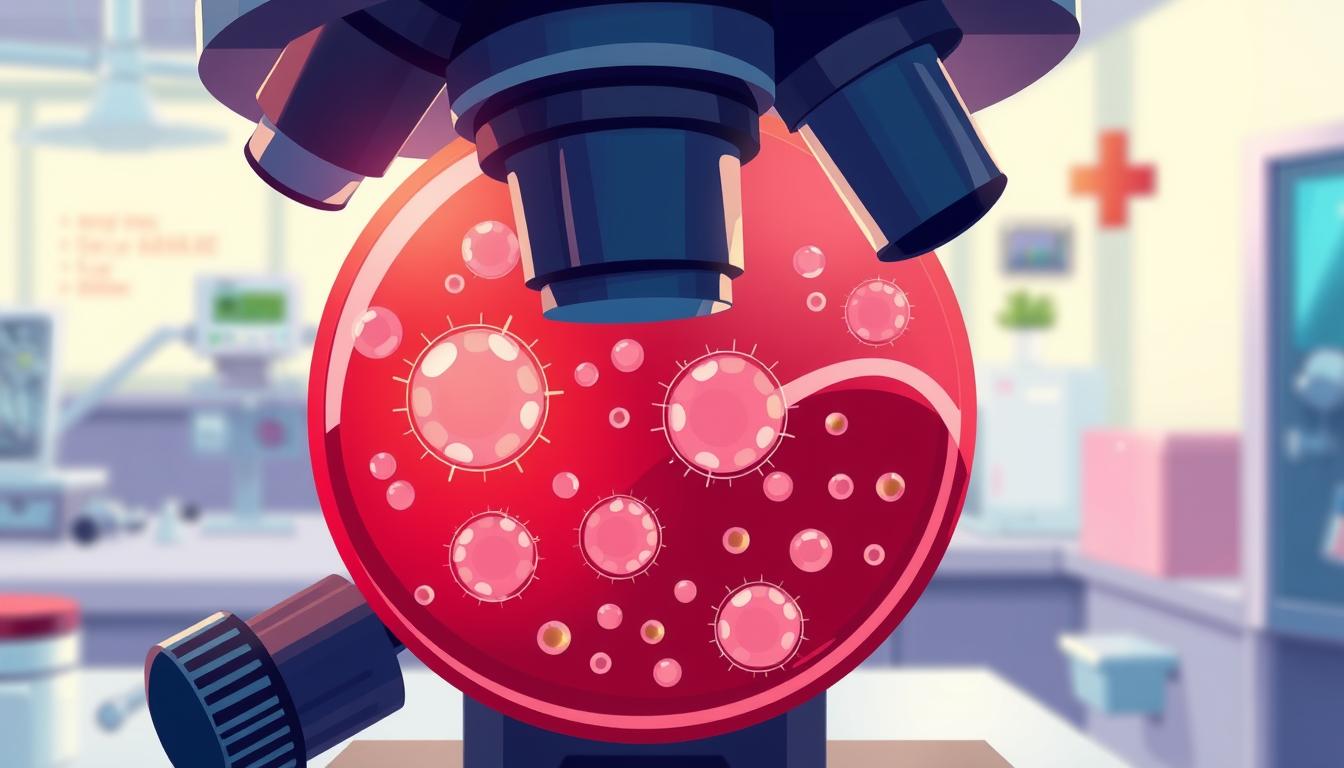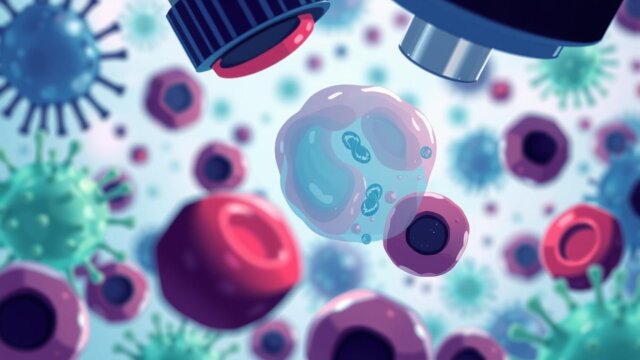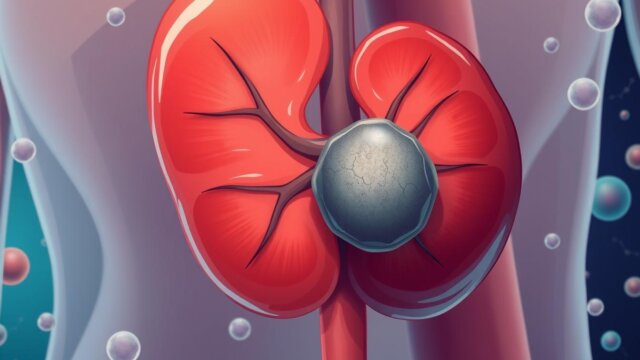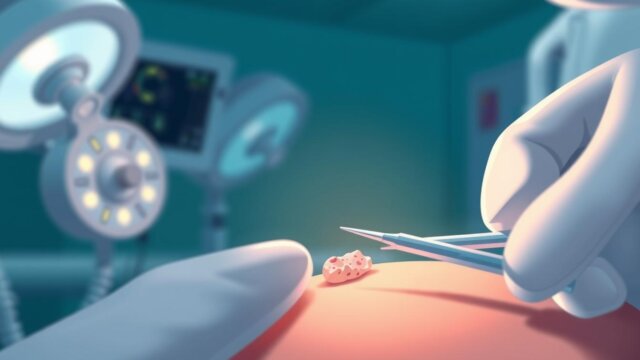FTC disclaimer: This post may contains affiliate links and we will be compensated if you click on a link and make a purchase.
Did you know that about 85% of people are diagnosed with chronic myeloid leukemia (CML) in its chronic phase? This blood cancer is chronic and develops slowly. But, thanks to new treatments, it’s now manageable for most patients. Knowing the basics of CML is key to dealing with it and finding the best treatments.
CML starts in the bone marrow, where blood cells are made. It happens when a bone marrow cell gets a chromosomal problem. This leads to an abnormal protein that makes CML cells grow too much. This can stop normal blood cells from growing, leading to health issues.
CML has three phases: chronic, accelerated, and blast. Most patients are diagnosed in the chronic phase, during which less than 5% of immature leukemic cells are in the bone marrow. The disease gets worse as the number of blast cells increases.
Key Takeaways
- CML is a chronic form of leukemia, a type of blood cancer that occurs due to a chromosomal abnormality in a single bone marrow cell.
- CML has three distinct phases: chronic, accelerated, and blast, defined by the percentage of immature leukemic blast cells.
- Approximately 85% of CML patients are diagnosed in the chronic phase, which is the most manageable phase of the disease.
- Targeted therapies called tyrosine kinase inhibitors (TKIs) have revolutionized CML treatment, transforming it from a life-threatening disease to a manageable chronic condition for most patients.
- Monitoring the response to CML treatment is essential, as it helps ensure the therapy’s effectiveness and identify potential complications.
What is Chronic Myeloid Leukemia?
Definition and Overview
Chronic myeloid leukemia (CML) is a cancer that starts in the bone marrow. It makes too many white blood cells called granulocytes or blasts. This stops normal blood cells from growing.
CML is slow-growing and mostly affects adults. It’s rare in kids.
CML goes through three phases: chronic, accelerated, and blastic. In the chronic phase, which is common at diagnosis, less than 10% of cells are blasts. Though slow, CML can turn into a fast-growing acute leukemia that’s hard to treat.
| Key Characteristics of CML |
|---|
| – Originates in the bone marrow, leading to an excess of white blood cells called granulocytes or blasts |
| – Typically progresses slowly, with three distinct phases (chronic, accelerated, and blastic) |
| – Most commonly diagnosed in the chronic phase, when less than 10% of cells are blast cells |
| – Can transform into a fast-growing acute leukemia that is difficult to treat |
| – Occurs mostly in adults, with rare occurrences in children |
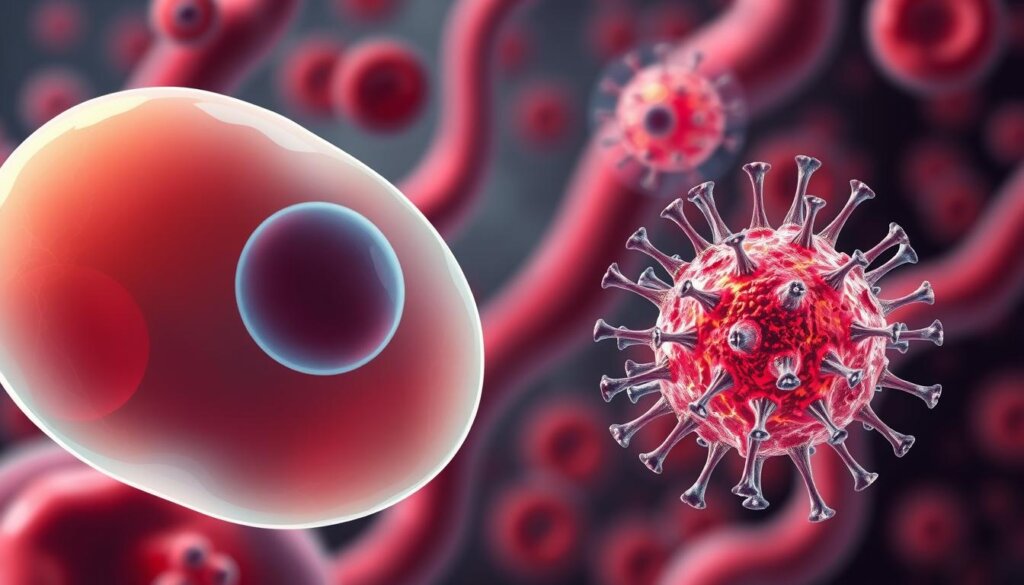
“Chronic leukemias can take a long time before causing problems, and most people can live for many years. Without treatment, most people with acute leukemia would only live a few months.”
Knowing about chronic myeloid leukemia is key to understanding this blood cancer. It’s a special type of myeloid leukemia that needs specific care and treatment.
Causes and Risk Factors
The exact cause of chronic myeloid leukemia (CML) is still a mystery. But it’s linked to a genetic mutation called the Philadelphia chromosome. This mutation leads to an abnormal BCR-ABL fusion protein, which makes CML cells grow and multiply without control.
Most CML cases don’t have a clear cause. But, some risk factors have been found. High-dose radiation, like from atomic bombs or nuclear accidents, is a big risk. Even X-rays and CT scans can slightly raise the risk, though it’s still low.
Age is another risk factor. CML is more common in older adults and rare in kids. It’s also a bit more common in men than women.
CML is not passed down from parents to children. There’s no proof that smoking, diet, chemicals, or infections cause CML.

In short, CML is caused by the Philadelphia chromosome, radiation, and age. It’s more common in older men. Knowing these factors helps us understand and prevent CML.
Symptoms and Early Detection
Many people with chronic myeloid leukemia (CML) don’t notice symptoms early on. But as it worsens, signs like fatigue and weight loss appear. An enlarged spleen, fever, and night sweats are also common.
Common Signs and Symptoms
CML can cause anemia, leading to weakness and shortness of breath. Low white blood cells also raise the risk of infections. Low blood platelets can cause easy bruising and bleeding. A blood test might first show an abnormal white blood cell count.
CML affects both men and women equally. It can happen to anyone, not just older adults. The disease is linked to the Philadelphia chromosome in 90% of cases.
Early detection and treatment are key to managing CML. Thanks to new treatments, most people can live for years after diagnosis.
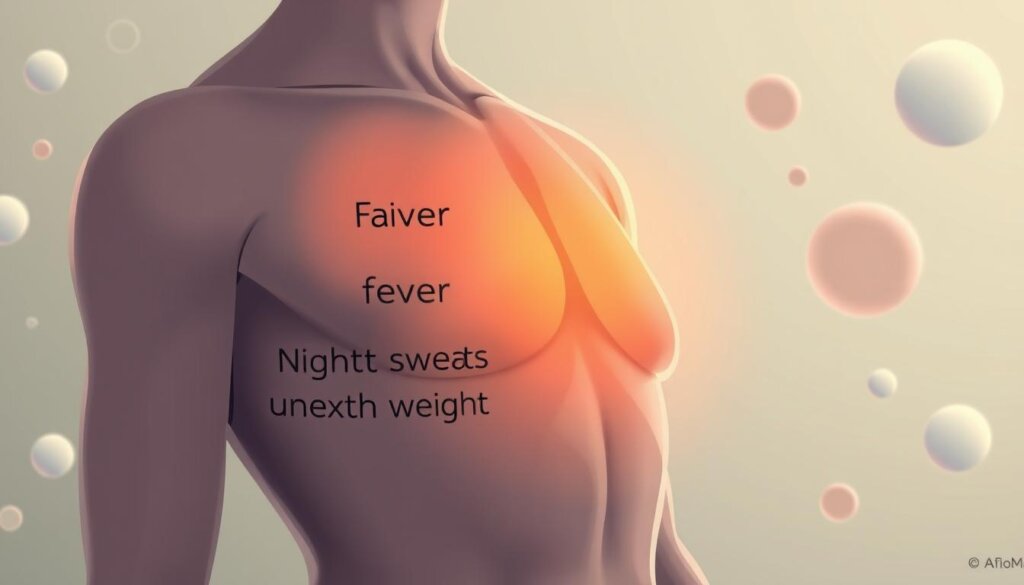
CML Symptom | Description |
|---|---|
Fatigue | Feelings of weakness and tiredness, often due to anemia. |
Weight Loss | Unexplained and unintentional weight loss. |
Spleen Enlargement | An enlarged spleen can cause a sense of fullness or discomfort in the abdomen. |
Fever and Night Sweats | Fever and excessive sweating, especially at night. |
Anemia | Shortage of red blood cells, leading to weakness, tiredness, and shortness of breath. |
Neutropenia | Low levels of normal white blood cells, increasing the risk of infections. |
Thrombocytopenia | Shortage of blood platelets, resulting in easy bruising and bleeding. |
“Early detection and prompt treatment are essential for managing CML effectively.”
The American Cancer Society and the Mayo Clinic share important information. They discuss CML symptoms, how it develops, and how treatment has improved.
Diagnostic Tests and Procedures
Diagnosing chronic myeloid leukemia (CML) requires many tests. The first is a complete blood count (CBC), which checks red, white, and platelets. People with CML often have too many white blood cells, including immature ones.
To confirm CML, doctors do a bone marrow test. This test looks for the Philadelphia (Ph) chromosome and the BCR-ABL gene in the bone marrow. About 95% of CML cases show the Ph chromosome.
More tests like fluorescence in situ hybridization (FISH) and reverse transcription-polymerase chain reaction (RT-PCR) might be needed. FISH finds the BCR-ABL gene well. RT-PCR checks for the gene in blood or bone marrow.
Test | Purpose |
|---|---|
Complete Blood Count (CBC) | Measures levels of red blood cells, white blood cells, and platelets |
Bone Marrow Aspiration and Biopsy | Analyzes bone marrow for the presence of Philadelphia chromosome and BCR-ABL fusion gene |
Cytogenetic Analysis | Detects the Philadelphia chromosome in about 95% of CML cases |
Fluorescence In Situ Hybridization (FISH) | Highly sensitive method for identifying the BCR-ABL fusion gene |
Reverse Transcription-Polymerase Chain Reaction (RT-PCR) | Precisely measures minimal traces of the BCR-ABL gene in blood or bone marrow |
Doctors use these tests to accurately diagnose CML and plan treatment.
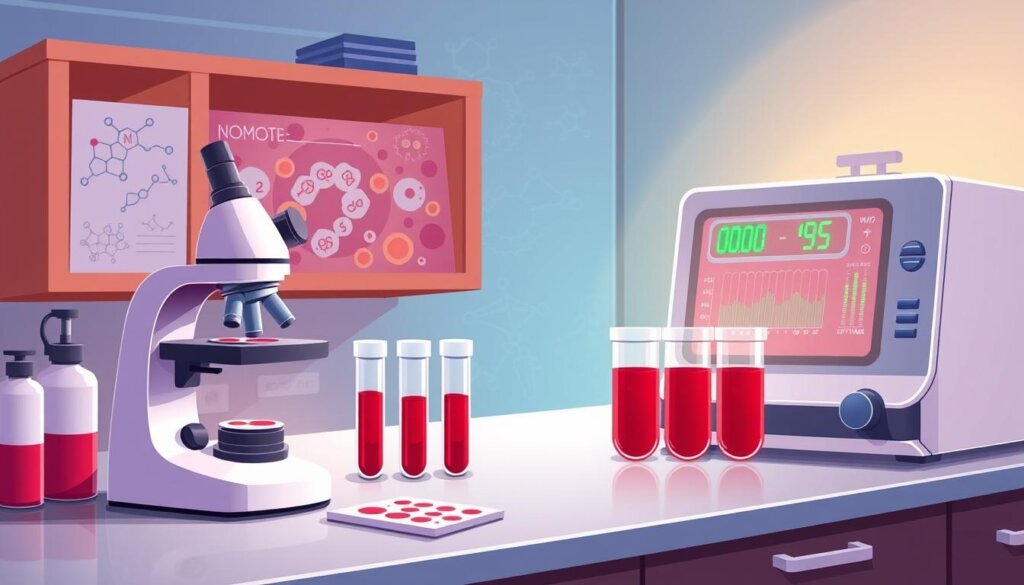
“Accurate diagnosis is crucial for effective treatment of chronic myeloid leukemia. The combination of blood tests, bone marrow analysis, and genetic testing provides a comprehensive picture of the disease, allowing for personalized care.”
Chronic Myeloid Leukemia Phases
Chronic myeloid leukemia (CML) goes through different phases. Each phase has its own traits. Knowing these phases helps doctors choose the right treatment and manage the disease well.
The Phases of Chronic Myeloid Leukemia
CML is split into three main phases: chronic, accelerated, and blast. The phase depends on the number of immature blast cells in the blood and bone marrow.
- Chronic Phase: This is the most common phase at diagnosis, with less than 10% blast cells in the blood and bone marrow.
- Accelerated Phase: In this phase, blast cells increase to 10-19% of the blood and bone marrow cells. Symptoms such as fatigue and weight loss may become more pronounced.
- Blast Phase (Blast Crisis): The blast phase, also known as the blast crisis, is the most aggressive and difficult-to-treat stage of CML. In this phase, the number of blast cells rises to 20% or more, and the leukemia may transform into a more acute form, such as acute myeloid leukemia.
Doctors use blood and bone marrow tests to determine a patient’s phase of CML. Knowing the phase is key to creating a good treatment plan and managing the disease well.
CML Phase | Blast Cell Percentage | Characteristics |
|---|---|---|
Chronic Phase | Less than 10% | Most common at diagnosis, fewer symptoms |
Accelerated Phase | 10-19% | More pronounced symptoms, higher number of blast cells |
Blast Phase (Blast Crisis) | 20% or more | Most aggressive and difficult to treat, leukemia may transform |
Understanding CML’s phases helps doctors create specific treatment plans. This way, they can give patients the best care and support during their fight with this complex disease.
Treatment Options for Chronic Myeloid Leukemia
Chronic myeloid leukemia (CML) is a slow-growing disease that affects blood and bone marrow. It often starts in middle age, but rarely in kids. Most people with CML have a specific gene change called the Philadelphia chromosome.
The main treatments for CML are tyrosine kinase inhibitors (TKIs) and stem cell transplants.
TKIs, like imatinib (Gleevec), dasatinib (Sprycel), and nilotinib (Tasigna), are pills that stop the bad BCR-ABL protein. They work well in the early stages of CML. Bosutinib (Bosulif), ponatinib (Iclusig), and asciminib (Scemblix) are also used for CML treatment.
These drugs can be the first choice for early CML or when other treatments fail.
Stem cell transplantation is used when TKIs don’t work anymore or when CML comes back. For advanced CML, allogeneic stem cell transplantation might be an option. Clinical trials are also a choice for those with resistant or relapsed CML.
Choosing a treatment depends on the CML phase, the patient’s health, and what they prefer. Treatment success depends on the CML phase, test results, and other factors. It’s important to talk about side effects, long-term effects, and clinical trials with the doctor.
Monitoring and Managing Treatment Response
Ongoing CML treatment monitoring is key to determining whether treatment works for chronic myeloid leukemia (CML). Doctors use blood tests to assess the patient’s hematologic, cytogenetic, and molecular responses.
A complete molecular response means no BCR-ABL gene is found. This shows all CML cells are gone, but it doesn’t mean the disease is cured. Regular checks help doctors make the right treatment choices for CML patients.
Evaluating Treatment Effectiveness
Most people get a complete hematological response in 3 months with TKIs. The PCR test shows how well the treatment is working. It looks at the molecular response (MR) levels.
A complete cytogenetic response means there are no or very few cells with the Philadelphia chromosome. Partial cytogenetic response means some cells have it. It takes about 6 months to see a complete cytogenetic response, but it varies.
A 4.5-log reduction in BCR::ABL1 levels means the disease is in remission. A 5-log reduction means the BCR::ABL1 is undetectable, a big win.
Response Type | Criteria |
|---|---|
Complete Cytogenetic Response | Less than 1% of bone marrow cells contain the Philadelphia chromosome |
Partial Cytogenetic Response | 1% to 35% of bone marrow cells have the Philadelphia chromosome |
Minor Cytogenetic Response | 36% to 65% of bone marrow cells contain the Philadelphia chromosome |
Minimal Cytogenetic Response | 66% to 95% of bone marrow cells contain the Philadelphia chromosome |
Regular visits are key for patients on TKIs. If CML stops responding to TKIs, patients might switch treatments or try a clinical trial.
“Careful monitoring helps guide treatment decisions and ensure the best possible outcomes for CML patients.”
Living with Chronic Myeloid Leukemia
Living with chronic myeloid leukemia (CML) means you must stick to your treatment plan. Tyrosine kinase inhibitors (TKIs) are the main treatment for CML. They can keep the cancer in check for. But it’s very important to take these medicines exactly as they were prescribed. Missing doses can cause the treatment to not work well.
It’s also key to managing the side effects of CML treatment, which can include fatigue, nausea, and diarrhea. Alternative therapies like acupuncture and probiotic supplements can help. They can make you feel better and improve your life.
The cost of CML treatment can be high. But there are ways to handle the cost. The cost depends on your insurance, where you live, and the type of medicine. Programs like those from the American Cancer Society can help with costs. Also, talking to your insurance company about costs can help you plan your finances.
Maintaining a healthy lifestyle is important for managing CML. Regular exercise, eating well, and managing stress can improve one’s life and health. It’s also good to talk to one’s employer and partner about changes during treatment.
Understanding the Disease and Treatment Options
CML is a common leukemia, making up almost 15% of cases. It’s more common in men than women; most cases happen in people over 65.
Even though there’s no cure for CML, new treatments have improved survival rates. The main treatment is targeted therapies, like tyrosine kinase inhibitors, which have greatly increased the survival chances of people with CML.
Regular check-ups are crucial for CML patients. Symptoms may appear in advanced stages, and survival chances drop.
CML is caused by a genetic mutation involving chromosomes 9 and 22. Doctors diagnose it using physical exams, blood tests, and bone marrow tests.
People with CML should take their medicines as directed and see their doctors regularly. Knowing about the disease and treatments helps them take charge of their care. Working closely with healthcare teams can help manage the disease and increase the chances of long-term survival.
“Living with CML requires a lifelong commitment to treatment, but with the right support and strategies, individuals can manage the disease and maintain a good quality of life.”
A person diagnosed with CML in December 2008 joined a clinical trial for ponatinib (Iclusig). They achieved remission for two years with no leukemia cells. But remission is not a cure. A friend died from CML after a bone marrow transplant.
Support Resources for CML Patients and Caregivers
Getting a CML diagnosis can feel overwhelming. But, you don’t have to face it alone. Many support resources are here to help. They offer important info, financial help, and a way to connect with others who get what you’re going through.
Patient Advocacy and Support Organizations
- The Leukemia & Lymphoma Society (LLS) offers educational materials, financial help, and online support groups for blood cancer patients and their families.
- The CML Advocates Network links over 100 leukemia groups from 80 countries. It’s a global forum for sharing information and resources.
- In the U.S., the National CML Society is a key spot for CML support, education, and advocacy.
- Young Adult Survivors United (YASU) helps those 18-39 with CML or blood cancers through support groups and financial aid.
- Latinas Contra Cancer offers monthly Spanish support groups for the Latino community. These groups meet the cultural and language needs of CML patients.
- Cancer Support Community’s Pride Cancer Support Group is a safe space for LGBTQIA+ people with CML and other blood cancers.
- Leukaemia CARE in the UK provides educational resources, emotional support, and advocacy to leukemia patients and their families.
Connecting with Others
Being part of an online community or support group is very helpful. It lets CML patients and caregivers share, learn, and find emotional support. Groups like the Leukemia & Lymphoma Society, the National CML Society, and Patient Power offer online and in-person groups to connect people with CML.
Financial Assistance
CML treatment can be very expensive. But there are ways to get help. Groups like the Leukemia & Lymphoma Society and Young Adult Survivors United offer financial aid. They help with care costs, travel, and other expenses.
Thanks to these organizations and communities, CML patients and caregivers can face their challenges more confidently and strongly. They can use the many educational, emotional, and financial resources available to actively participate in their care and find the support they need to do well.
Ongoing Research and Clinical Trials
Research on chronic myeloid leukemia (CML) is growing. New treatments, including new tyrosine kinase inhibitors and targeted treatments, are being tested in clinical trials.
Personalized medicine is also being explored. It uses genetic and molecular profiling to tailor treatments. This could lead to better treatments and a better life for CML patients.
Studies are looking at using higher doses of tyrosine kinase inhibitors (TKIs) and combining them with other treatments. Researchers are also studying how to stop TKI treatment and manage disease recurrence. Ponatinib is effective for patients with a specific mutation, making targeted therapies crucial.
New drugs targeting the BCR-ABL gene are being developed. Clinical trials are also testing the use of immunotherapy drugs with TKIs, which shows the search for new ways to treat CML.
Patients with CML can live as long as people without the disease. The STIM trial showed patients stayed in complete molecular remission for 2 years after stopping imatinib. The STIM1 study in France also showed promising results.
The DADI trial found that some patients could stop taking dasatinib and still stay in remission. A study also showed that interferon treatment is effective for CML. Another study compared busulfan and interferon-alpha for newly diagnosed patients.
CML mostly affects older people, with most cases in those over 65. It is rare in children. The disease is caused by a genetic abnormality that leads to cancerous cell growth.
Targeted therapy drugs have greatly improved survival rates for CML patients. Today, over 70% of patients survive for five years. Risk factors include age, gender, and radiation exposure, especially from nuclear bombs.
“Ongoing research in chronic myeloid leukemia is focused on developing more effective and well-tolerated therapies, with the goal of improving long-term disease control and quality of life for patients.”
Conclusion
Chronic myeloid leukemia (CML) is a complex blood cancer. But, thanks to new treatments, it’s now manageable for many. Targeted tyrosine kinase inhibitors have greatly improved life for CML patients.
CML is still a tough disease that needs careful watching and tailored treatments. Knowing the basics, recognizing signs, and using support resources are key. This helps patients and their families deal with CML and aim for the best outcomes.
The American Cancer Society, National Cancer Institute, and top medical journals have shared important information on CML. This knowledge, along with doctor advice, helps patients make smart choices and participate in their care. Understanding CML and the help available can lead to a brighter, more hopeful future for those with this chronic blood cancer.
FAQ
What is chronic myeloid leukemia (CML)?
CML is a slow-growing blood cancer. It starts in the bone marrow’s blood cells. It makes too many abnormal white blood cells, crowding out normal ones.
What causes CML, and what are the risk factors?
We don’t know what causes CML, but a genetic mutation called the Philadelphia chromosome is linked to it. This mutation makes an abnormal protein that makes CML cells grow too much. High-dose radiation and some medical tests can also increase the risk, but it’s still low.
What are the common signs and symptoms of CML?
Many people with CML don’t show symptoms at first, but they might find out during a routine blood test. As the disease gets worse, symptoms like tiredness, weight loss, and feeling full can occur. It can also cause anemia and make it hard to fight infections.
How is CML diagnosed?
Doctors use tests like a complete blood count and bone marrow tests to find CML. These tests look for the Philadelphia chromosome and the BCR-ABL gene. More tests might be needed to confirm the diagnosis and see how far the disease has spread.
What are the different phases of CML?
CML has three phases based on the number of immature cells. The chronic phase is the most common at diagnosis. The disease can get worse, entering the accelerated and then blast phases. The blast phase is the most aggressive.
What are the main treatments for CML?
The main treatments are tyrosine kinase inhibitors (TKIs) and stem cell transplants. TKIs, like imatinib, block the BCR-ABL protein. Stem cell transplants are used when TKIs stop working, or the disease comes back.
How is the effectiveness of CML treatment monitored?
Doctors check how well treatment is working with blood tests. They look for the disappearance of CML cells and the BCR-ABL gene. A complete molecular response means all detectable CML cells are gone, but it doesn’t mean the disease is cured.
What are the key considerations for living with CML?
Living with CML means sticking to treatment and working with doctors. Taking TKI medications as directed is crucial. Managing side effects and staying healthy can also improve life quality.
What support resources are available for CML patients and caregivers?
Organizations like the Leukemia & Lymphoma Society offer help. They have educational materials, financial aid, and support groups. Connecting with others can offer emotional support and practical advice.
What is the current state of CML research and clinical trials?
New research and therapies are improving CML treatment. Clinical trials are investigating new treatments and ways to improve their effectiveness. This could lead to more effective treatments and better quality of life for CML patients.
